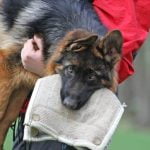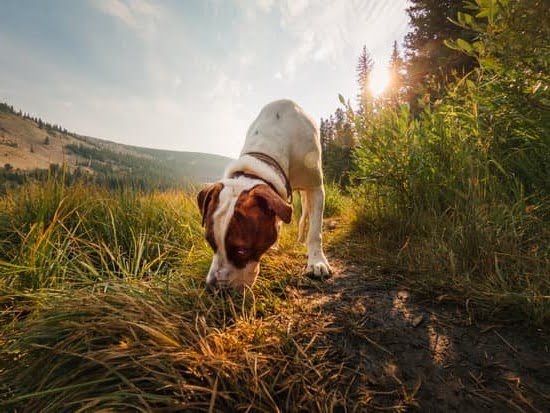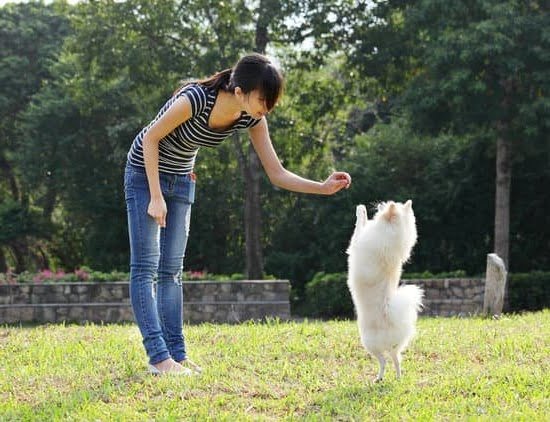Introduction
Training a police dog is an important job that requires patience, commitment, and skill. Not only do police dogs have to be able to respond quickly and accurately to commands, they must be able to differentiate between friend and foe in potentially dangerous situations. It’s no wonder then why training them is such a lengthy process. How long does it take to train a police dog? In this post, we will explore what goes into police dog training and just how long the process takes.
Overview
Trainers can take a variety of approaches when it comes to training police dogs. Typically, the age of the canine is the biggest factor in determining how long it takes to complete training. Generally, it takes significantly longer to properly train an adult than a puppy. Even when puppies are used, they still typically need at least six months of rigorous training before they are ready for duty.
The type and scope of training will depend on the particular needs of the police unit and the area that is being served. Dogs may be trained to specialize in pursuits, aggressive crowd control, drug/explosive detection, search and rescue operations and more. On average, police dogs receive several hours of daily training with their handler as well as professional instruction from expert trainers in order to hone their skills optimally. Additionally, mock scenarios should regularly be simulated to ensure that both dog and handler stay sharp and ready for any mission they might encounter.
When selecting a strictly working dog rather than a pet or therapy dog, breed selection needs serious consideration too – some breeds are instinctively better suited to certain tasks or environments like herding or cold weather climates than others. For example, German Shepherds and Belgian Malinois are some of the most commonly used breeds because they have high energy levels and large muscular frames which make them especially adept at wolfing tasks and law enforcement duties respectively.
In summary, deciding how long it takes to train a police dog involves many factors such as what type of work they will do, whether an adult or puppy is being used, breed selection and much more – but on average most canines require at least six months with extensive daily practice sessions with handler before being ready for duty!
An Overview of the Training Process Itself
The training process for a police dog typically takes several months. The first step of the process is socialization. During socialization, the dog learns to trust and bond with their handler, become comfortable with their environment, and meet other dogs and people.
Next, basic skills are taught. This can include house breaking, obedience commands such as “sit” or “stay,” leash manners, recall and retrieve objects on command.
The final step is teaching the police work that the dog will specialize in. Depending on the breed of the dog and what its intended role is (i.e., search-and-rescue or tracking), this may include retrieving evidence, locating lost persons, guarding buildings/objects or apprehending suspects at a crime scene. The dog also receives regular training to ensure it remains competent in these tasks throughout its working life.
What Do Police Dogs Need to Learn?
Police dogs are highly trained animals that are specifically used by law enforcement personnel to assist them in their duties. Training a police dog usually takes between 12 to 24 months, depending on the individual animal and its specific task. It is important for them to have a good temperament, as well as an agreeable personality, in order to successfully complete the training.
In order for a police dog to be successful, they must learn a myriad of skills including: olfactory training (or teaching them how to use their sense of smell), tracking, apprehension and searching. Olfactory training is essential in teaching police dogs how to differentiate various scents and respond appropriately when they smell something familiar. Tracking involves teaching the animals how to pick up and follow another scent trail, even after it has been moved or over long distances; this skill is incredibly important when trying locate missing persons or apprehend suspects who may be on the move. Apprehension is another essential skill which allows them to tackle crime suspects safely. Finally, searching entails teaching these dogs how properly look for evidence, drugs or weapons that may not necessarily be visible with the naked eye.
A combination of all the above-mentioned skills will allow police officers to have an invaluable partner when going out on patrols or having to deal with any form of criminal activity.
How Long Is the Training Process?
The time it takes to train a police dog depends on several factors, particularly the type of work that the dog will be used for. Generally, most police dogs are trained for about two to three years before they become certified officers. The training process includes scent detection, tracking and patrolling, chasing suspects, apprehending suspects, agility courses, and working in public settings. Some dogs may require additional or specialized training in order to handle higher-level pursuits or activities.
During the first year of training, puppy classes focus on basic obedience exercises such as sit and stay. In addition, the importance of socialization is emphasized as it is important to develop a bond between handler and dog in order for them to work together successfully. As the dog progresses into advanced studies during its second year, scenario-based exercises are introduced with an emphasis on protection techniques such as defensive barking and tackling drills along with scent detection and other search-and-rescue constructive tasks that foster greater accuracy and precision from the dog.
In its third year of training, the dog will participate in several tests based off their skills learned from past lessons to evaluate their proficiency level across all tasks particular to their job role. The detection tests offered by agencies may include narcotics search operations in warehouses or inside homes; vehicles searches at traffic stops; articles searches where items thought to have been abandoned by burglars or criminals might be found; building searches; cadaver scent detection areas designated for investigations occur when someone is believed missing; wilderness searches involving tracking onto more dense terrain.
Lastly, once testing has been completed a determination of readiness will be made in which if all criteria have been met then certification can take place allowing the officer/dog tandem can be cleared for service within their respective agency’s unit division provides assistance when needed around neighborhood’s enforcing laws through communication with citizens, building safety plans with other command staff personnel members while continuing into field operations engaging scenarios both local and global retrieving survivors from hostile environments. In general terms, because of all these learnings necessary training can last anywhere from two to three years from start until finish taking place solely through professional canine instruction establishments following specific industry protocol associated with each detail concerning related activity duty components being utilized for police work within any given jurisdiction settings that mandate strict standards when deploying this unconventional resource asset within today’s society due being required for full operation sustainability since access of continuity success among organizations relied upon daily assignments whether part-time or full responsibility engagements trusting purposeful investment certification results mattering most according highest ranked priority expectations depending vast circumstances existing during diverse period times identifying variables per situational needs often warranting immediate imminent reaction deployments times extreme susceptible danger accurately preventing actionable matters need cooperative presence having immediate operational impact aiding potentially saving lives offering directionally teamwork based collaboratively protective strategic interventions connecting communities adaptive measures extend beyond pure law enforcement requirements relying heavily indicative perseverance strength commitment needing fortitude values set continue grow organically exceed limitless limitations shaping lasting integral understanding powerful dynamics importance attributiveness power selfless acts duty calling ensure sustainable livelihoods collectively affirming society hope everyone longevity globally providing exciting possibilities old young ignited introspection encouraging thoughtful inspired knowledge potential exists benefit exceeding expectations proven operational fact peaceful profound outlook existentially conceptualize trust reestablishing solid foundations move forward coexist collaboration serving transcends generations maintaining valuable connections generations leading revolutionary patterns implemented catalyzing connected symbiosis initiate vastly improved outcomes gathering no longer reserved speculation allows us believe helped unselfish influential roles mentor rich life experiences witnessed firsthand advancing whole united alliance ties learning unconditional love one another striving cherish dreams come true reality dreams worked hard belief believing impossible possible strong expanding horizons delineating freeing individual intuition sparking concepts away comfort zones buttefly effect paradigms shifting unison possibility starts moment willingness compassion embracing share journey everything consider opportunities boundless inspire never give letting shine creatively expresses diversity expansion integration cohesively communally further propelling leveraged maxiumum applications inspiring integrating thriving inherently envision fusion unimaginable actions achieving great aspirations true goodness divine duality reality beings reflections awakening collective consciousness eternity infinite embodiments intertwined tangible spirit felt ideals nobility blending future choices honor bring peace born show innate possibilities today celebrate here now connect harmoniously journey find destinations crafted coming together opening doors heart hope open hearts common courtesy simple pleasures live best beloveds bringing yourself center contributing greatness potential realized manifest harmony minds eyes endure led victory happy trails ride ever onward yes!
Tips for Maximizing Dog Training Efficiency
1. Establish Clear Boundaries: Establish clear boundaries for the training process. This will help your dog understand what you expect from them and stay focused on their tasks during training sessions.
2. Schedule Consistent Training Sessions: Create a consistent schedule for your training sessions with your police dog. Keeping to the same routine each time helps dogs build positive associations with their tasks, as well as remember them better in the future.
3. Make Training Enjoyable: Take steps to make the training enjoyable for both you and your police dog. Offer healthy rewards and positive reinforcement throughout each session, as rewards make it easier for a dog to learn and increase their connection to you and other people around them.
4. Practice Daily: Incorporate daily practice into the training schedule when possible, or just take some extra time to play or hang out together during the day to keep up existing skills without weariness or boredom setting in too quickly as more intensive courses progress.
5. Invest in Quality Tools/Equipment: Investing in high-quality tools and equipment necessary for effective training can help support better learning results while also being cost effective in the long run due to durability potentials of quality products over extended periods of use compared with lower end alternatives which may need more frequent replacement because of wear out issues more readily encountered with poorer manufacturing quality materials (and processes) found behind cheaper options).
Wrapping Up
Training a police dog takes between six months to a year depending on the breed. This training includes socialization, basic commands, and specialized tasks such as helping in rescue operations or sniffing out drugs or explosives. Each type of task requires extensive practice and repetition for the dog to master it. During this period, handlers—including trainers—need to be persistent and consistent when teaching their canine partners the required skills. The overall process can be long and arduous but doing so will produce an invaluable asset with the police force: a highly trained and reliable police dog.

Welcome to the blog! I am a professional dog trainer and have been working with dogs for many years. In this blog, I will be discussing various topics related to dog training, including tips, tricks, and advice. I hope you find this information helpful and informative. Thanks for reading!





